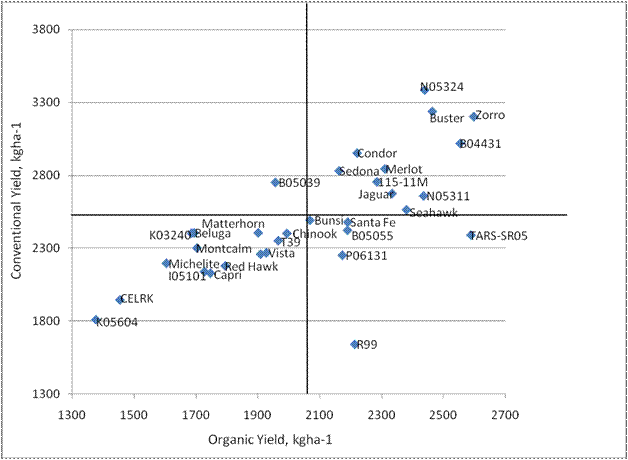Organic Bean Production
Preamble: In 2016, the United States had 14,217 certified organic farms that produced $7.6 billion in certified organic products. Michigan had 402 certified organic farms that produced $201.1 million in certified organic products. Of the 76,192 acres of certified land in Michigan, 66,663 acres were cropland and 9,529 acres were pastureland/rangeland. The top two certified commodities sold in Michigan were corn for grain or seed with sales valued at $12.6 million and dry edible beans with sales valued at $7.6 million (NASS, 2016). Organic bean production is relatively small when compared to conventional production in the US, but many large scale bean producers in Michigan are considering organic production given the price advantage (~150%) for the organic crop. In a recent study at MSU, the highest yielding bean varieties developed under conventional management systems were also the highest yielding under organic systems (Figure 1).The same array of agronomic, disease resistance and phenology traits that dominate the focus of the breeding program are important in both production systems. Neglected among these traits are plant nutrition traits including tolerance to low soil fertility, nutrient use efficiency, and symbiotic nitrogen fixation (SNF). As growers struggle to optimize yields in an environmentally sustainable fashion, bean breeders are again considering the genetic enhancement of beans for efficient use of nutrients. Enhancing SNF ability of dry beans through breeding and selection would provide growers with option of reducing fertilizer costs and the commensurate potential contamination of ground water. Bean growers in the Saginaw Valley and thumb of Michigan farm in the Great Lakes water shed and any loss of nitrogen through leaching poses problems that require action. Reducing the amount of fertilizer used to produce a successful bean crop would improve land stewardship and avoid potential environmental issues in the future. Current research is underway to genetically enhance the SNF capacity of contemporary dry bean varieties grown by farmers in Michigan.
NASS, 2016. www.nass.usda.gov/organics
https://www.nass.usda.gov/Surveys/Guide_to_NASS_Surveys/Organic_Production/2016_State_Publications/index.php

Figure 1. Scatter plot of yield (kg/ha) of 32 dry bean varieties grown under organic and conventional treatments at the Kellogg Biological Station, Gull Lake, MI for 3-years 2007-2009. Conventional yield is on the Y-axis and organic yield on the X-axis. [Abstracted from: Heilig, J.A., and J.D. Kelly. 2012. Performance of dry bean genotypes grown under organic and conventional production systems in Michigan. Agron. J. 104:1485-1492.]



 Print
Print Email
Email